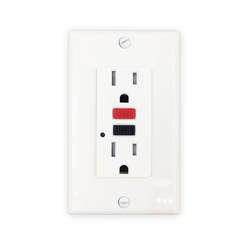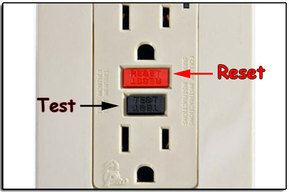Last week, I introduced you to the GFCI (sometimes shortened to GFI) outlet. I talked about how they function, why they are necessary, and where they should be located. To summarize, they are safety devices designed to prevent fatal electrocution accidents and should be located in all wet areas and areas with good potential for ground contact (think exterior). This week I will go into the different types of GFCI devices, common installation practices, and how to test them.
Types of GFCI Devices
GFCI Breaker
Two types of GFCI devices commonly seen in a home inspection are outlets and circuit breakers. GFCI circuit breakers are located at, you guessed it, the main breaker panel. These protect all of the outlets on the circuit and don’t require any GFCI outlets to be installed in the circuit. GFCI beakers are often used to protect jacuzzi tubs where the outlet for the pump is concealed inside the tub enclosure. This prevents having to disassemble the tub enclosure to reset the outlet in the event of it tripping. These devices have a test button just like the outlets; to reset them you simply turn the breaker back on. If your wondering, “What does a GFCI look like?”, take a look at the pictures below.


GFCI Outlet
The other type of GFCI device, which I have already talked a little about, is the GFCI outlet. You’ve probably already seen them around your house. A distinguishing feature of a GFCI outlet is the presence of two buttons, one which says “TEST” and another labeled “RESET.” We will discuss these buttons and their functions in a bit. Similar to the GFCI breakers, a single GFCI outlet can protect other non- GFCI outlets on the circuit as well. If you look on the back of a GFCI outlet you will see terminal screws labeled line and load. Power coming into the outlet should be wired to the “line” side of the outlet. Any outlets to be protected “downstream” of the GFCI outlet should be wired to the “load” side of the outlet. Many homes use a GFCI outlet located in the garage to control or protect all of the exterior outlets. They may also install a GFCI in one bathroom that protects all of the other bathroom outlets. Each house is different, but a thorough home inspector will note GFCI outlet locations and the outlets they may or may not protect.
Testing GFCI Devices
Just like smoke detectors and other home safety devices, GFCI outlets should be tested regularly to ensure they are functioning properly. As part of a your home maintenance plan, you should test GFCI outlets monthly. Luckily, it is a very simple process. All you have to do is push the test button. When you push the test button, you can have a few possible outcomes:
- The outlet will trip, shutting down the power and the reset button will pop out. This means the outlet is functioning properly. Simply press the reset button and go about your business.
- Nothing’s happens. This means the outlet has gone bad and should be replaced.
- The outlet trips, or at least the reset button pops out, but the power does not shut off. This usually indicates that the line and load wires are reversed. The outlet will not protect you from a shock. This should be corrected.
- The outlet was already tripped. The reset button was popped out and will not go back in. This means the outlet has already gone bad and needs to be replaced. Some newer outlets will not reset if the line and load wires are reversed. This is a safety feature built in from the manufacturer.
 GFCI Buttons
GFCI Buttons
Now, suppose you want to find out which non-GFCI outlets in your house are protected by an upstream GFCI outlet. A simple way to test them, the way I test them during an inspection, is to use a GFCI outlet tester. The tester can be found at your local home improvement store for under 10 dollars. You simply insert the tester into the Non-GFCI outlet and press the test button. If the power goes out, you know the outlet is protected. The trick can be figuring out which GFCI outlet is protecting it. I recommend making sure the house is nice and quiet so you can listen for the GFCI outlet to trip so you can determine its location. There’s almost nothing more frustrating than a tripped GFCI that you can’t find.
I hope I’ve answered any questions you may have had about GFCI outlets. If not, drop me a comment below and I’ll answer it or make it a future blog post!

